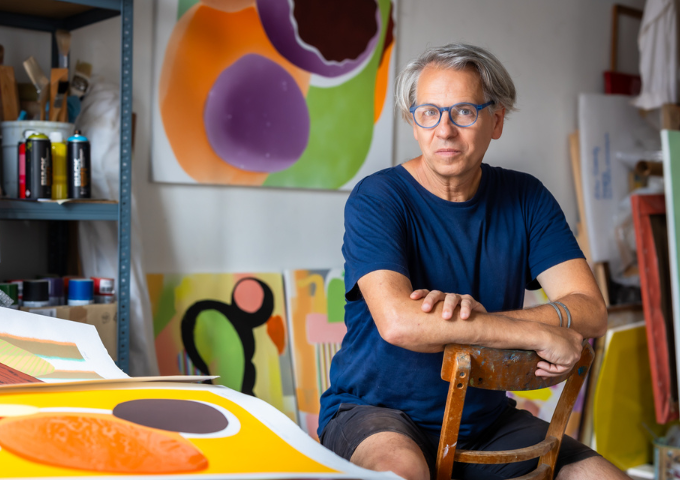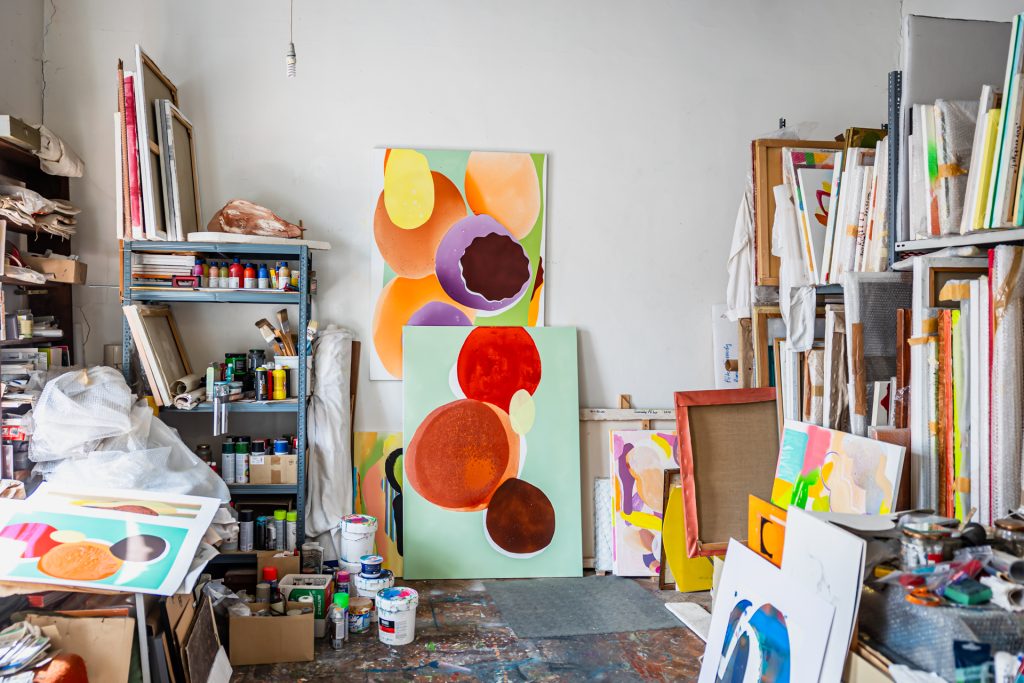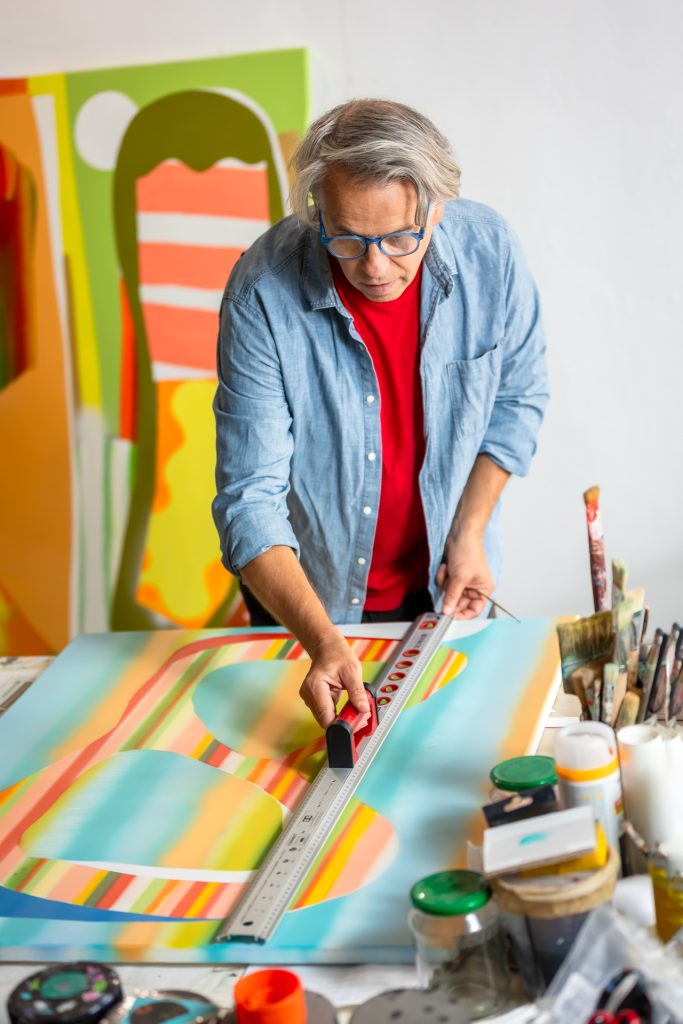The MNB collection includes almost twenty of works of Munkácsy Prize-winning painter Péter Somody. We talked to the artist, who lives and works in Pécs, about the city’s art life, the LokArt festival in June and his teaching activities at the Faculty of Music and Art of the University of Pécs.
We meet at the LokArt art festival in Pécs, where several of his paintings were exhibited, both at the M21 gallery and at the Nick Gallery, which is celebrating its tenth anniversary. And if we are talking about the Pécs art festival, the question arises: what is it like to be an artist in Pécs?
I was born in Veszprém, but I came here to Pécs to study from Ilona Keserü as a student majoring in drawing. In fact, it is through her that I became the follower of a deep-rooted tradition of Pécs. Ilona attended private early evening drawing classes with Ferenc Martyn when she was a child. Martyn’s inspiration from French art and the essence of his friendships with French artists are already present in Ilona Keserü’s art. Ferenc Lantos also went to Martyn, but toughened it bit by taking his paintings in the direction of analytical art. Nevertheless, the Mediterranean atmosphere of Pécs can be felt in the hidden, but tangible layers of the works of all of us. The atmosphere created here is reinforced, unintentionally, by those of us who live here or have moved here.
Ilona Keserü also has a number of paintings in the MNB collection, and many of her students are represented from all generations. What was she like as a teacher?
She started teaching at the university when I arrived here, in 1984. She was ambitious and wanted to offer us a lot of the world, her point of view, to our great good fortune. She didn’t show us brushwork techniques, although we could see a lot of it down to the smallest touches, as we went up to her studio to talk. She was open, she liked having us around and that we were interested. She still spends a lot of time in Pécs and to this day we are close friends with Ilona and the fellow students from back then.
But now you are the head of the doctoral school, you shifted sides, you have become a master. How much do you like teaching?
I don’t really have a problem with age, or with the passing of time, it’s going to get worse. My involvement in the doctoral school was fueled by local patriotism on the one hand, and on the other, I wanted to take the approach I had received – which we have just discussed – further.
It is our generation’s turn to pass on to young people what we have learned from our great predecessors. This is why I took up the position as the head of the doctoral school for five years, even though it requires constant consultation and attention. I keep a tight little calendar for myself so that nothing falls through the cracks of my memory and try to keep time for painting and my studio. Luckily, I’m a night owl, and in the evening, when the world and my family are quiet around me, I go to the studio and often paint until one o’clock at night.
Can you paint by lamplight? Don’t you need daylight?
I use great daylight frequency lamps, but I make my decisions earlier, during the optimum period of light. Decisions made during the day can be continued in the evening under the lights.
How can you summarise what you want to pass on to young people?
Today’s young people have to cope in different circumstances than we did in the early nineties, a few years after the regime change. This is a very different society now. They are flooded with all the news, information and opportunities in the world, so young people need to be calmed down, because they are almost neurotic about it. In this hurried, impatient world, they must learn to shut out everything else and maintain the conditions for peaceful creation. One thing I always recommend is for them to try to go abroad on scholarships. I learned a lot from the 4-5 years I spent intermittently in Germany, Cologne, Bonn, Munich, in the second half of the 90s. At the Academy in Munich, as a scholarship holder, I got to know Günther Förg, Professor Jürgen Reika, Gerd Winner and many good teachers. At the time, Emő Simonyi, who was a classmate of Gyula Konkoly at the Academy of Fine Arts in Budapest, was also teaching anatomy there, and occasionally, when we really needed it, he would invite us to dinner.
Have you maintained your contacts in Germany?
I made lasting contacts, I worked for a long time with galleries in Munich and Nuremberg, but after I settled down at the art faculty in Pécs and started a family, my travels became less frequent. I don’t go to Germany three times a year anymore, I’m a bit out of the art scene there, but my personal relationships are still active. Fortunately, many of my friends came to Pécs to visit.
What is it that you brought with you from Munich that has been imprinted on your art?
I think I learned work and courage. Less deliberation, less struggle, more trying out what comes to mind, because only then will I find out if it works.
Your paintings are both planned and playfully spontaneous, a kind of ambivalence describes them. Is all this conscious?
I run at least two threads at once. While I’m working, new ideas often pop up, new directions open up, but I don’t have time to take every fork in the road. I need to decide quickly which one I can take further, but if I don’t remind myself of a side street, I’ll regret passing it. I make a few images of it, and then continue where I left off the original. You have to do whatever slips your way when you’re in the moment, otherwise the moment will pass.
Nowadays our basic experience is uncertainty, and it seems as if this mood of the times is present in your paintings.
I read quite a lot about this – as in the doubts about the very existence of art – in Hungarian and in German, in the art press. There are many different trends present. One feels an inner compulsion to create one’s own world of images with such character that lets them be recognised by it. In my opinion it is not only the visual world that can be a distinguishing feature, but also the artistic habitus, the inventiveness, the taste, the thoughtfulness. I am not only interested in painting, but I don’t have time for my installation work at the moment. I have a studio and a small warehouse almost full, because even though I feel like I don’t work much, I do work a lot.
The MNB has a complete collection (18-19 paintings) of your work. What characterises these images?
I tried to put together a body of work that shows the continuity and diversity of my oeuvre. It includes works from the late 90s and the late 2010s. I’m very happy to have my old large format paintings included, because they are in a good place in the MNB collection. There I have the forms derived from paint spills, with a transposed formal world, and the more recent paintings, where the surface is not shaped by the material, but by the striation, the frequency, that is set in place. The meshes are reorchestrated and work with almost the same drop-shaped flowing forms.
Do you also agree that there is a strong link between painting and music?
Even back in the eighties, I used to listen to music all the time while painting. At the time, it was still a matter of coordinated choices, but listening to the music of the time, the first Genesis albums, the minimalist yet terribly poetic music of Peter Gabriel and Laurie Anderson, when the sounds almost became colours or movements in space, I felt as if they were directly feeding my intuition.
Music was another source of inspiration for me, besides the Keserü-Konkoly master school in István-akna, which is still an almost completely unprocessed, silenced thing, but it was a super fantastic place, a master laboratory. Ilona started the school of painting with Gyula Konkoly in a mining camp in the woods near Pécs, which gave the basis of today’s Faculty of Arts. This is where we came out from, Tibor Gyenis, Tamás Enyingi, István Losonczi, Szilárd Cseke, Judit Horváth, András Hajdú, Ferenc Kósa, Rita Mátis and myself. It was a great thing and we owe a lot to that period.










